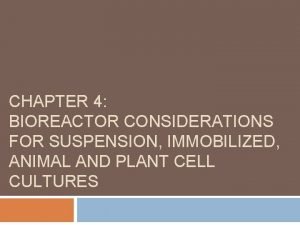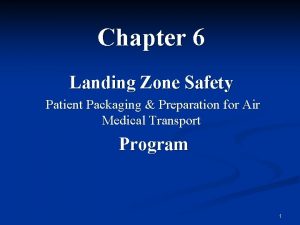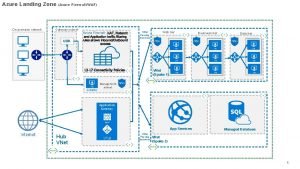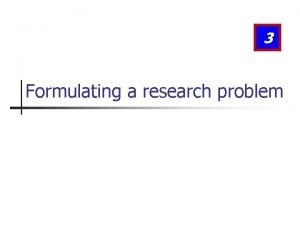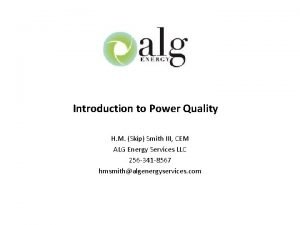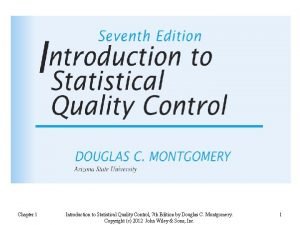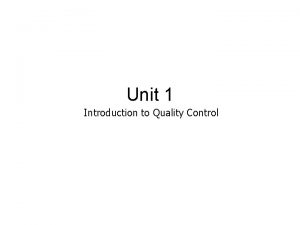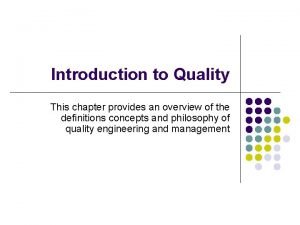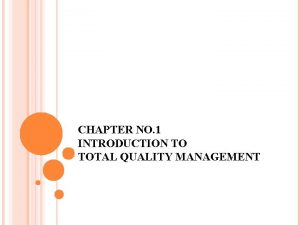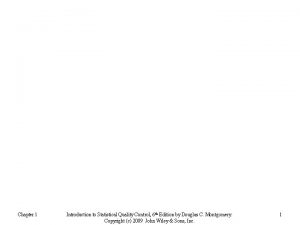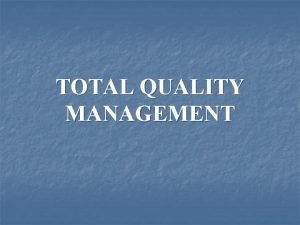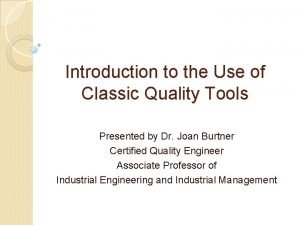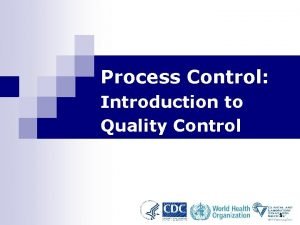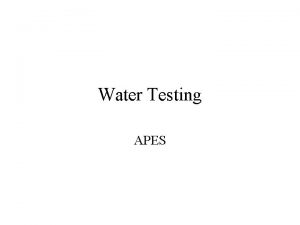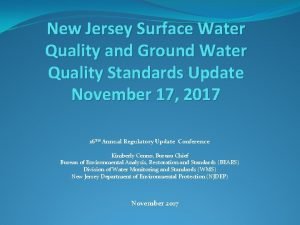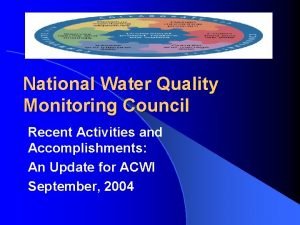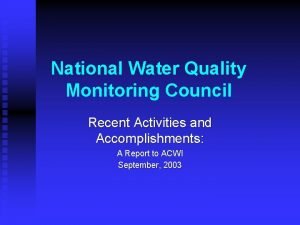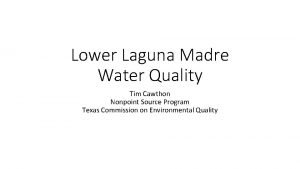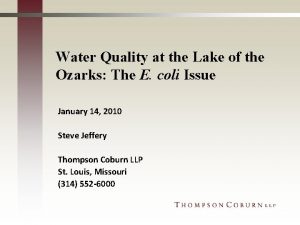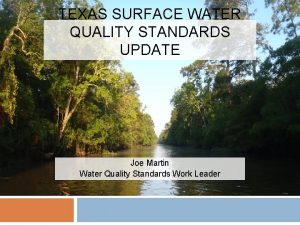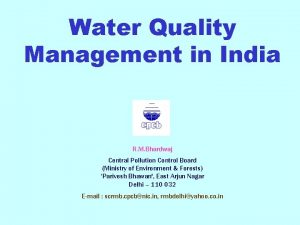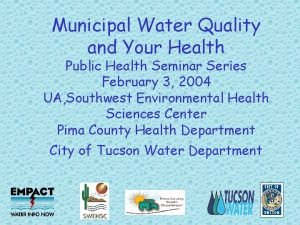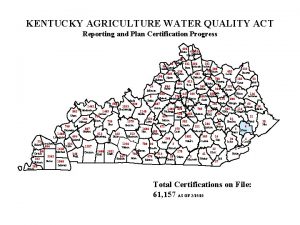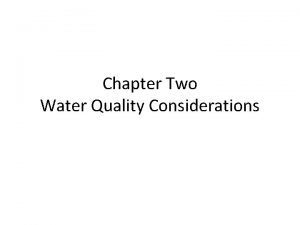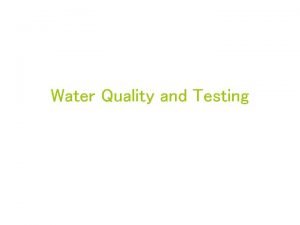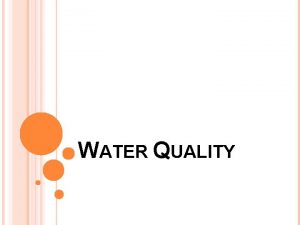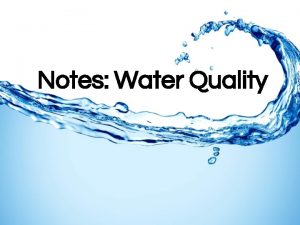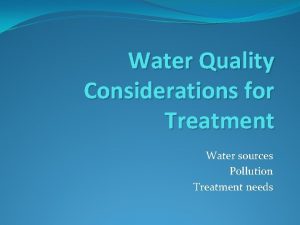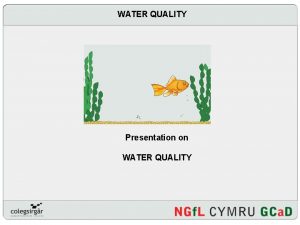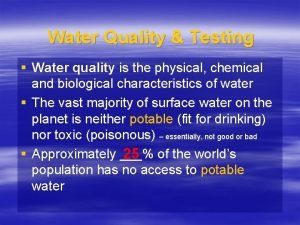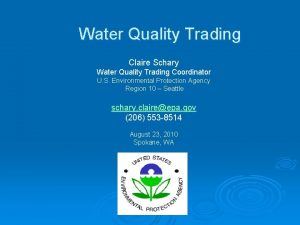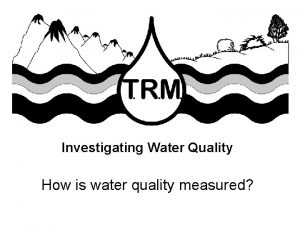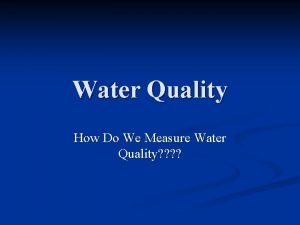Chapter Two Water Quality Considerations INTRODUCTION Water quality









































































- Slides: 73

Chapter Two Water Quality Considerations

INTRODUCTION Water quality is the most important issue in water reuse systems that determines the acceptability and safety of the use of recycled water for a given reuse application. For each category of water reuse, the definition of appropriate water quality is driven by a number of health, safety, sociopsychological, and technical economic criteria (Figure 2. 1).


INTRODUCTION As a rule, water quality objectives are set by guidelines and regulations, which in turn determine the treatment technology to be used. Table 2. 1 shows the list of parameters used in the evaluation of water quality for irrigation (the most important parameters are given in bold).


INTRODUCTION The typical concentrations in raw municipal wastewater and the main characteristics and impacts of these parameters for water reuse are given in Table 2. 2. Of the four categories, microbiological parameters have received the most attention. Since monitoring for all pathogens is not realistic, specific target organisms such as fecal or total coliforms are being used as indicators of potential health risk.



INTRODUCTION In addition, other parameters are chosen and used for regulatory purposes and to monitor the treatment efficiency of a process or before reuse, depending on the type of reuse or regional specificities. For example, water salinity is of great concern in agricultural reuse, while trace organics are of lesser concern for agricultural reuse but are an important issue for potable reuse.

INTRODUCTION Wastewater quality data routinely measured and reported are mostly in terms of general parameters (e. g. , biochemical oxygen demand [BOD 5 ], suspended solids [SS], chemical oxygen demand [COD], which are of interest in water pollution control in receiving water bodies. While monitoring of suspended solids can be useful to predict clogging problems in irrigation systems, COD and BOD 5 usually are not directly used in irrigation project planning, although organic constituents can be problematic if present in high concentrations.

INTRODUCTION The evaluation of nutrient content of wastewater (N and P) is becoming increasingly important to avoid eutrophication, as well as to assess the fertilizing value of these waters.

INTRODUCTION The main factors that affect recycled water quality include: • • source control, type of sewage system, wastewater treatment and operation, and storage and distribution

PARAMETERS WITH HEALTH SIGNIFICANCE Biological risks related to water reuse have been recognized since the very beginning of irrigation with wastewater. On the other hand, the considerations related to chemical risks have been developed recently following improvements in analytical capabilities. Additionally, biological risks have a relatively immediate outcome (illnesses develop in a short period of time), while chemical risks are translated into time-delayed illnesses (carcinogens, long-term toxicity, etc. ).

PARAMETERS WITH HEALTH SIGNIFICANCE 1. Chemicals Human health-related issues involving toxic chemicals have been reported only for irrigation with wastewater heavily polluted by industrial waste discharge. Municipal wastewater that has limited industrial wastewater input generally contains concentrations of organic and inorganic compounds that do not present health concerns when the recycled water is used for irrigation.

PARAMETERS WITH HEALTH SIGNIFICANCE 1. Chemicals The principal health hazards associated with chemical constituents of recycled water arise from the contamination of crops or groundwater by the following compounds: • Cumulative poisons, principally trace elements (heavy metals). • Carcinogens, mainly organic chemicals.

PARAMETERS WITH HEALTH SIGNIFICANCE 1. Chemicals • Pharmaceuticals (antibiotics, synthetic drugs) and personal care products. • Other compounds suspected to exert endocrine disruption properties (hormones or other chemicals such as PCBs, octilphenol, nonilphenol, etc. )

PARAMETERS WITH HEALTH SIGNIFICANCE 1. Chemicals During the last 10 years, an impressive improvement in analytical capacity has led to the discovery in natural waters of a huge amount of substances capable of exerting negative effects on humans. Health-related concerns (endocrine disruption, feminization of fishes, antibiotic resistance of pathogens, etc. ) pertaining to endocrine disruptors, pharmaceuticals, and personal care products in raw wastewater, recycled water, and other waters are receiving increased attention, as is the removal of these constituents during wastewater treatment and soil percolation.

PARAMETERS WITH HEALTH SIGNIFICANCE 1. Chemicals This is currently a fertile field for research, because such compounds enter the water cycle through wastewater disposal. This knowledge creates an additional motivation to find treatments to eliminate such substances, which are usually present in very low concentrations.

PARAMETERS WITH HEALTH SIGNIFICANCE 2. Pathogens The greatest health concern when using recycled water for irrigation is related to pathogens that could be present. It is widely known that it is not practical to establish the presence or absence of all pathogenic organisms in wastewater or recycled water in a timely fashion. For this reason, the indicator organism concept was established many years ago to allow monitoring of a limited number of microbiological constituents.

PARAMETERS WITH HEALTH SIGNIFICANCE 2. Pathogens Table 2. 3 enumerates the microbiological organisms (pathogens and indicator organisms) that are usually analyzed for to establish the presence or absence of health hazards. Table 2. 4 provides the survival time of some common pathogens under different conditions in fresh water, sludge, soil, and crops.




PARAMETERS WITH HEALTH SIGNIFICANCE 2. Pathogens Epidemiological studies conducted to date have not established definitive adverse health impacts attributable to the use of appropriately treated recycled water for irrigation. Nevertheless, there is clear epidemiological evidence of health problems when raw or improperly treated wastewater is used for irrigation in areas where such infections are endemic. Table 2. 5 summarizes the findings of some of these studies.


PARAMETERS WITH HEALTH SIGNIFICANCE 2. Pathogens Adverse health effects have been detected only in association with the use of raw or poorly settled wastewater, while inconclusive evidence suggested that appropriate wastewater treatment could provide a high level of health protection. Natural barriers also reduce threat of crop contamination by pathogens. Cell walls of plant roots and leaves filter the irrigation water, and microorganisms cannot readily pass through and into the edible tissues of the crops unless the cell walls are injured.

PARAMETERS WITH HEALTH SIGNIFICANCE 2. Pathogens Moreover, drying and solar radiation further prevent any organisms remaining in irrigation water from continuing to be viable on plant surfaces as long as there is an adequate drying period after the last irrigation and before harvest. These mechanisms normally provide a high level of natural protection against contamination of food crops from many pathogens that might be present in recycled water.

PARAMETERS WITH HEALTH SIGNIFICANCE 2. Pathogens Potential risks induced by the presence of pathogenic microorganisms in wastewater or on crops may become actual risks if the following four criteria occur: 1. The pathogen must reach the plant or be able to multiply to the number required for an infective dose. 2. A human host must come into contact with the infective dose of the pathogen. 3. The host must become infected. 4. Disease results from the infection or leads to further transmission.

PARAMETERS WITH AGRONOMIC SIGNIFICANCE Important agricultural water quality parameters include a number of specific properties of water that are relevant in relation to the: • yield and quality of crops, • maintenance of soil productivity, and • protection of the environment.

PARAMETERS WITH AGRONOMIC SIGNIFICANCE The quality of irrigation water is of particular importance in arid zones where extremes of temperature and low relative humidity result in high rates of evaporation with consequent deposition of salt, which tends to accumulate in the soil profile.

PARAMETERS WITH AGRONOMIC SIGNIFICANCE The physical and mechanical properties of the soil, such as soil structure (stability of aggregates) and permeability, are very sensitive to the type of exchangeable ions present in irrigation water. Thus, when water reuse is being planned, several factors related to soil properties must be taken into consideration.

PARAMETERS WITH AGRONOMIC SIGNIFICANCE 1. Salinity Compared to many other irrigation waters, recycled water generally has a low to medium salinity with electrical conductivity of 0. 6 to 1. 7 d. S/m. Some dissolved mineral salts are identified as nutrients and are beneficial for plant growth, while others may be phytotoxic or may become so at high concentrations.

PARAMETERS WITH AGRONOMIC SIGNIFICANCE 1. Salinity The major salinity sources in recycled water are: • drinking water (especially hardness and naturally occurring salts), • salts added by urban or industrial water use, • infiltration of brackish water into sewers, and • agricultural irrigation (impact on groundwater salinity).

PARAMETERS WITH AGRONOMIC SIGNIFICANCE 1. Salinity in the soil is related to, and often determined by, the salinity of irrigation water. The rate at which salts accumulate to undesirable levels in soils depends on the following factors: 1. Their concentration in the irrigation water 2. The amount of water applied annually 3. Annual precipitation 4. Evapotranspiration 5. Soil characteristics, both physical and chemical

PARAMETERS WITH AGRONOMIC SIGNIFICANCE 1. Salinity Dissolved salts increase the osmotic pressure of soil water and consequently lead to an increase in the energy plants must expend to take up water from the soil. As a result, respiration is increased and the growth and yield of most plants decline progressively as osmotic pressure increases.

PARAMETERS WITH AGRONOMIC SIGNIFICANCE 1. Salinity Water salinity can be reported either as total dissolved solids (TDS, mg/L) or as electrical conductivity (ECw ), measured in mmhos/cm or most correctly in d. S/m. The relationship between ECw and TDS is approximately ECw (d. S/m)× 640= TDS (mg/L). The symbol ECe is used to designate the electrical conductivity of the soil saturation extract.

PARAMETERS WITH AGRONOMIC SIGNIFICANCE 1. Salinity Recently, the classification of saline water has been reconsidered (Table 2. 6) on the basis of research and practical observations. This classification must be used only as a guideline to determine the level of salinity of irrigation waters. It is important to stress that Table 2. 6 cannot be used to assess the suitability of saline water for irrigation, because a number of other conditions must be taken into account, including crop, climate, soil, irrigation method, and management practices


PARAMETERS WITH AGRONOMIC SIGNIFICANCE 2. Toxic Ions Many of the ions that are harmless or even beneficial at relatively low concentrations may become toxic to plants at high concentration This effect could result either from: • direct interference with the metabolic processes. • indirect effects on other nutrients, which might be rendered unavailable.

PARAMETERS WITH AGRONOMIC SIGNIFICANCE 2. Toxic Ions Toxicity normally results in impaired growth, reduced yield, changes in the morphology of the plant, and even its death. The degree of damage depends on the: • Crop, • stage of growth, • concentration of the toxic ion or ions • relationships, • climate, and • soil conditions.

PARAMETERS WITH AGRONOMIC SIGNIFICANCE 2. Toxic Ions The most common phytotoxic ions that may be present in municipal effluents in concentrations high enough to cause toxicity are Boron (B), Chloride (Cl), and Sodium (Na). Each can cause damage individually or in combination.

PARAMETERS WITH AGRONOMIC SIGNIFICANCE 2. Toxic Ions Sodium and chloride are usually absorbed by the roots but can also enter directly into the plant through the leaves when moistened during sprinkler irrigation. This typically occurs during periods of high temperature and low humidity. Leaf absorption speeds up the rate of accumulation of a toxic ion and may be a primary source of toxicity.

PARAMETERS WITH AGRONOMIC SIGNIFICANCE 2. Toxic Ions Boron can become toxic at levels only slightly greater than those required by plants for good growth. The predominant source of anthropogenic boron is domestic effluents, due to the use of perborate as a bleaching agent. As a result, boron can be found in urban wastewater at concentration levels as high as 5 mg/L (dry countries and concentrated sewage), with an average level around 1 mg/L

PARAMETERS WITH AGRONOMIC SIGNIFICANCE 2. Toxic Ions It should be noted that boron at concentrations of less than 1 mg/L is essential for plant development, but higher levels can cause problems in sensitive plants. Most plants exhibit toxicity problems when the concentration of boron exceeds 2 mg/L.

PARAMETERS WITH AGRONOMIC SIGNIFICANCE 3. Sodium Adsorption Ratio Sodium is a unique cation because of its effect on soil. When present in the soil in exchangeable form, sodium causes adverse physical-chemical changes, particularly to soil structure, which results in dispersion of particles and, consequently, reduced infiltration rates of water and air into the soil.

PARAMETERS WITH AGRONOMIC SIGNIFICANCE 3. Sodium Adsorption Ratio As a rule, recycled water could be a source of excess Na in the soil compared to other cations (Ca, K, Mg), and for this reason it should be monitored. The most reliable index of the sodium hazard of irrigation water is the sodium adsorption ratio SAR. The sodium adsorption ratio is defined by Equation (2. 1), where the ion concentrations are expressed in meq/L:

PARAMETERS WITH AGRONOMIC SIGNIFICANCE 3. Sodium Adsorption Ratio If significant precipitation or dissolution of calcium due to the effect of carbon dioxide (CO 2 ), bicarbonate (HCO 3) and total salinity (ECw ) is suspected, an alternative procedure for calculating an adjusted sodium adsorption ratio (SARadj ) can be used. Where:

PARAMETERS WITH AGRONOMIC SIGNIFICANCE 3. Sodium Adsorption Ratio Na = sodium in the irrigation water reported in meq/l Cax= a modified calcium value taken from Table 11, reported in meq/l. Cax represents Ca in the applied irrigation water but modified due to salinity of the applied water (ECw), its HCO 3/Ca ratio (HCO 3 and Ca in me/l) and the estimated partial pressure of CO 2 in the surface few millimetres of soil (PCO 2 = 0. 0007 atmospheres) Mg = magnesium in the irrigation water reported in meq/l

PARAMETERS WITH AGRONOMIC SIGNIFICANCE 3. Sodium Adsorption Ratio The threshold value of SAR of less than 3 indicates no restriction on the use of recycled water for irrigation, while severe damage could be observed when SAR is over 9, in particular for surface irrigation. At a given SAR, the infiltration rate increases as salinity increases or decreases when salinity decreases. Therefore, SAR and ECw should be used in combination to evaluate the potential problem. Recycled water is often high in sodium, and the resulting high SAR is a major concern in planning water reuse projects.

PARAMETERS WITH AGRONOMIC SIGNIFICANCE 4. Trace Elements Urban wastewater may contain trace elements at concentrations that will give rise to high levels of such elements in the soil and cause undesirable accumulations in plant tissues and crop growth reduction. Trace elements are readily fixed and accumulate in soils with repeated irrigation with such recycled waters and may render them nonproductive or the product unusable. Surveys of irrigation with recycled water have shown that more than 85% of the applied trace elements are likely to accumulate in the soil, most at or near the surface, and may be leached to groundwater.

PARAMETERS WITH AGRONOMIC SIGNIFICANCE 4. Trace Elements Trace elements are not normally included in the routine analysis of regular irrigation water, but attention should be paid to them when using treated municipal effluents, particularly if contamination with industrial wastewater discharge is suspected. (see following table)



PARAMETERS WITH AGRONOMIC SIGNIFICANCE 4. Trace Elements A distinction is made between permanent irrigation of all soils (low maximum contaminant levels) and up to 20 years of irrigation of fine-textured neutral to alkaline soil, where higher concentrations of trace elements can be tolerated. These concentrations are set because of concern for long-term build-up of trace elements in the soil and for protection of agricultural soils from irreversible damage. Under normal irrigation practices, these suggested levels should prevent a build-up that might limit future crop production or utilization of the final product.

PARAMETERS WITH AGRONOMIC SIGNIFICANCE 4. Trace Elements Several long-term field experiments have been conducted in different countries on the impact of land application of recycled water on soils, microorganisms, and plants. Long-term environmental impact from irrigation with recycled water was reported to be minimal. 4 It was demonstrated that heavy metals such as Cu, Cr, Ni, and Zn accumulated at the top of the soil (1– 2 m) after 20 years of irrigation with recycled water in the Dan region of Israel.

PARAMETERS WITH AGRONOMIC SIGNIFICANCE 4. Trace Elements Some trace elements are essential at low concentrations (following table) but toxic at elevated concentrations (e. g. , Cu, Cr, Mo, Ni, Se, and Zn). As, Cr+6, Fl, Pb, Hg, Mo, and Se are considered to be of environmental concern because they are taken up by plants in amounts potentially harmful to animals and humans.


PARAMETERS WITH AGRONOMIC SIGNIFICANCE 4. Trace Elements B, Cd, Cu, Cr+6, Ni, Zn, and Se are of concern because of their phytotoxicity. These elements can be transferred to animals or humans through different pathways and, depending on their concentration, may cause human health effects.

PARAMETERS WITH AGRONOMIC SIGNIFICANCE 4. Trace Elements Trace element accumulation in soils in relation to uptake by plants depends on the chemical forms of the elements, which can be in exchangeable, sorbed, organic-bound, carbonate, and sulfide forms. Their accumulation by plants depends on the soil supplying these elements to plant roots, on the rhizosphere environment, and on the characteristics of the plant root system.

PARAMETERS WITH AGRONOMIC SIGNIFICANCE 4. Trace Elements Soil p. H has been shown to have a significant effect on plant uptake of trace elements in biosolids, much more consistently than other soil variables such as organic matter content, cation exchange capacity, and soil texture. Trace element toxicities to plants are more common in acid soils. Other soil components such as clay, organic matter, hydrous iron and hydrous manganese oxides, organic acids, amino acids, and humic and fulvic acids can also react to prevent trace element movement.

PARAMETERS WITH AGRONOMIC SIGNIFICANCE 5. p. H is an indicator of the acidity or alkalinity of water but is seldom a problem by itself. The normal p. H range for irrigation water is from 6. 5 to 8. 4. p. H values outside this range provide an indication that the water is abnormal in quality. In this case, irrigation water may cause a nutritional imbalance affecting plant growth and health. Moreover, abnormal p. H can be very corrosive to such appurtenances as pipelines, sprinklers, and control valves. Normally, p. H is a routine measurement in irrigation water quality assessment as it may be an indication of the presence of toxic ions.

PARAMETERS WITH AGRONOMIC SIGNIFICANCE 6. Bicarbonate and Carbonate Substantial bicarbonate levels (>3– 4 meq/L or >180– 240 mg/L) can increase soil p. H and, in combination with carbonate, may affect soil permeability. Bicarbonate ion may combine with calcium or magnesium and precipitate as calcium carbonate or magnesium carbonate, increasing the SAR in the soil solution due to a lowering of the dissolved calcium concentration.

PARAMETERS WITH AGRONOMIC SIGNIFICANCE 6. Bicarbonate and Carbonate Water containing excess bicarbonate and carbonate can leave white lime deposits on leaves of plants irrigated with overhead sprinklers during hot periods. These white formations reduce the aesthetic quality of the plants and certainly their marketability. In addition, these deposits can accumulate to cause clogging of small openings in irrigation equipment such as drip emitters and spray nozzles.

PARAMETERS WITH AGRONOMIC SIGNIFICANCE 6. Bicarbonate and Carbonate The water quality limit for bicarbonate (HCO 3) to avoid foliar deposits in the case of sprinkler irrigation is 90 mg/L (1. 5 meq/L). Severe plant damage could occur when bicarbonate concentration is over 500 mg/L (8. 5 meq/L).

PARAMETERS WITH AGRONOMIC SIGNIFICANCE 7. Nutrients The most important nutrients for crops are nitrogen, phosphorus, potassium, zinc, boron, and sulfur. Usually, recycled water contains enough of these elements to supply a large portion of a crop’s needs.

PARAMETERS WITH AGRONOMIC SIGNIFICANCE 7. Nutrients The most beneficial nutrient for plants is nitrogen. Both the concentration and forms of nitrogen (nitrate and ammonium) need to be considered in irrigation water. The relative proportion of each form varies with the origin and treatment of the wastewater, but most commonly ammonium is the principal form, usually present in a concentration range of 5 to 40 mg. N–NH 4/L.

PARAMETERS WITH AGRONOMIC SIGNIFICANCE 7. Nutrients During aerobic wastewater treatment, some ammonium could be oxidized to nitrates through the action of nitrifying bacteria. Common nitrate concentrations in urban wastewater range from 0 to 30 mg. N–NO 3/L.

PARAMETERS WITH AGRONOMIC SIGNIFICANCE 7. Nutrients Nitrogen is a macronutrient for plants that is applied on a regular basis. Nevertheless, at very high concentrations (over 30 mg. Ntot/L) it can over-stimulate plant growth, causing problems such as lodging and excessive foliar growth and also delay maturity or result in poor crop quality.

PARAMETERS WITH AGRONOMIC SIGNIFICANCE 7. Nutrients Nitrogen sensitivity varies with the development stage of the crops. It may be beneficial during growth stages, but causes yield losses during flowering/fruiting stages. The long-term effects of excess nitrogen include weak stalks, stems, and/or branches unable to support the weight of the vegetation under windy or rainy conditions.

PARAMETERS WITH AGRONOMIC SIGNIFICANCE 7. Nutrients Pollution of groundwater from the percolation of nitrogen presents a health concern. This usually results from excessive application of nutrients in areas having permeable soils. When nitrogen is washed from soils and reaches streams, lakes, canals, and drainage ditches, it stimulates algae growth, which can result in plugged filters, valves, pipelines, and sprinklers. In addition, excessive nitrogen application to pastures may be hazardous to livestock that consume the vegetation.

PARAMETERS WITH AGRONOMIC SIGNIFICANCE 7. Nutrients Potassium in recycled water has little effect on crops. The phosphorus content in recycled water is too low to meet a crop’s needs. Over time, phosphorus can build up in the soil and reduce the need for supplementation. Although excessive phosphorus does not appear to cause serious immediate problems to crops, it may affect future land use because some plants species are sensitive to high phosphorus concentrations. Phosphorus can also be a problem in surface water runoff as a limiting factor in eutrophication.

PARAMETERS WITH AGRONOMIC SIGNIFICANCE 8. Free Chlorine For sprinkler irrigation, excessive residual chlorine in recycled water causes plant damage if high residual chlorine exists at the time of irrigation. As free chlorine (Cl 2) is highly reactive and unstable in water, a high level of residual chlorine rapidly dissipates if the treated water is stored in reservoirs for more than few hours.

PARAMETERS WITH AGRONOMIC SIGNIFICANCE 8. Free Chlorine Residual free chlorine concentrations below 1 mg/L are not likely to affect plant foliage. Some damage may occur on very sensitive species at relatively low levels of about 0. 5 mg/L. Severe plant damage of a burning nature can occur in the presence of excessive free chlorine. Most reuse strategies will not face this problem if an intermediate storage facility is used, but care is needed during any period where the storage facility is bypassed for direct irrigation from the treatment plant.
 Water and water and water water
Water and water and water water What is basal state in phlebotomy
What is basal state in phlebotomy General consideration in machine design
General consideration in machine design Tax considerations for setting up a new business
Tax considerations for setting up a new business Software architecture of atm machine
Software architecture of atm machine Exchange transaction and relationship in marketing
Exchange transaction and relationship in marketing Mechanical considerations of transmission line
Mechanical considerations of transmission line Database design considerations
Database design considerations Psychomotor considerations language acquisition
Psychomotor considerations language acquisition Cloud delivery model
Cloud delivery model Writing strategies and ethical considerations
Writing strategies and ethical considerations Bioreactor considerations for animal cell culture
Bioreactor considerations for animal cell culture Collaboration design considerations
Collaboration design considerations Principle of tooth preparation
Principle of tooth preparation Antecubial region
Antecubial region Biopharmaceutic considerations in drug product design
Biopharmaceutic considerations in drug product design Retromylohyoid space
Retromylohyoid space Dogso spa
Dogso spa Design considerations icons
Design considerations icons Acclimatisation pdhpe
Acclimatisation pdhpe Gastrectomy anesthesia considerations
Gastrectomy anesthesia considerations Quasi experimental design ethical issues
Quasi experimental design ethical issues Capk expired
Capk expired Design considerations for mobile computing
Design considerations for mobile computing Qualitative proposal example
Qualitative proposal example T piece ventilation
T piece ventilation Ethical considerations examples
Ethical considerations examples Considerations examples
Considerations examples Web security considerations
Web security considerations Practical considerations for costume design might include
Practical considerations for costume design might include Pricing considerations and approaches
Pricing considerations and approaches Operational considerations definition
Operational considerations definition Moral consideration in ethics
Moral consideration in ethics Azure landing zone considerations
Azure landing zone considerations Data warehouse considerations
Data warehouse considerations Azure zone region
Azure zone region Eswl anesthesia considerations
Eswl anesthesia considerations Formulating objectives examples
Formulating objectives examples A paved blacktop parking lot was built
A paved blacktop parking lot was built Quality assurance vs quality control
Quality assurance vs quality control Pmp quality vs grade
Pmp quality vs grade What are quality standards in project management
What are quality standards in project management Quality assurance model in nursing
Quality assurance model in nursing Quality improvement vs quality assurance
Quality improvement vs quality assurance Basic concept of quality management
Basic concept of quality management Quality gurus and their contribution
Quality gurus and their contribution Quality is free: the art of making quality certain
Quality is free: the art of making quality certain What is tqm
What is tqm Chapter 9 surface water answer key
Chapter 9 surface water answer key Introduction to quality management
Introduction to quality management What is power quality definition
What is power quality definition Introduction to statistical quality control montgomery
Introduction to statistical quality control montgomery Introduction to quality control
Introduction to quality control Fundamental principles of tqm
Fundamental principles of tqm Introduction to quality
Introduction to quality Introduction of total quality management
Introduction of total quality management Introduction to data quality
Introduction to data quality Introduction to statistical quality control
Introduction to statistical quality control Introduction to software quality assurance
Introduction to software quality assurance Introduction to total quality management
Introduction to total quality management Introduction to quality tools
Introduction to quality tools Introduction to quality control
Introduction to quality control Turbidity apes
Turbidity apes Kathryn timmerman
Kathryn timmerman Njdep surface water quality standards
Njdep surface water quality standards National water quality monitoring council
National water quality monitoring council National water quality monitoring council
National water quality monitoring council Tceq segment viewer
Tceq segment viewer Lake of the ozarks pollution
Lake of the ozarks pollution Texas surface water quality standards
Texas surface water quality standards Water quality management in india
Water quality management in india Tucson water quality
Tucson water quality Kentucky agriculture water quality plan
Kentucky agriculture water quality plan National water quality monitoring conference
National water quality monitoring conference











